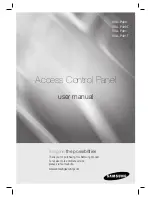
Chapter 4 WLAN Settings
NXC-8160 User’s Guide
48
4.2.1.2 Encryption
Wireless networks can use encryption to protect the information that is sent in the wireless
network. Encryption is like a secret code. If you do not know the secret code, you cannot
understand the message.
The types of encryption you can choose depend on the type of user authentication.
For example, if the wireless network has a RADIUS server, you can choose
WEP & 802.1x
Authentication
or
WPA
. If users do not log in to the wireless network, you can choose no
encryption,
WEP
or
WPA-Personal
or
WPA-Enterprise
.
Usually, you should set up the strongest encryption that every wireless client in the wireless
network supports. For example, suppose the AP does not have a local user database, and you
do not have a RADIUS server. Therefore, there is no user authentication. Suppose the wireless
network has two wireless clients. Device A only supports WEP, and device B supports WEP
and WPA. Therefore, you should set up
WEP
in the wireless network.
"
It is recommended that wireless clients use
WPA-Personal
,
WPA-Enterprise
,
or stronger encryption. IEEE 802.1x and WEP encryption are better than none
at all, but it is still possible for unauthorized devices to figure out the original
information pretty quickly.
It is not possible to use
WPA
or stronger encryption with a local user database. In this case, it
is better to set up stronger encryption with no authentication than to set up weaker encryption
with the local user database.
Many types of encryption use a key to protect the information in the wireless network. The
longer the key, the stronger the encryption. Every wireless client in the wireless network must
have the same key.
4.2.1.3 Additional Installation Requirements for Using 802.1x
• A computer with an IEEE 802.11 compatible wireless LAN card.
• A computer equipped with a web browser (with JavaScript enabled) and/or Telnet.
• A wireless station must be running IEEE 802.1x-compliant software. Currently, this is
offered in Windows XP.
• An optional network RADIUS server for remote user authentication and accounting.
Table 10
Types of Encryption for Each Type of Authentication
NO AUTHENTICATION
RADIUS SERVER
Weakest
No Security
WEP
WEP + 802.1x Authentication
WPA-Personal
WPA
Strongest
WPA-Enterprise
WPA
Summary of Contents for NXC-8160
Page 1: ...www zyxel com NXC 8160 Business WLAN Controller User s Guide Version 1 0 12 2008 Edition 2...
Page 2: ......
Page 8: ...Safety Warnings NXC 8160 User s Guide 8...
Page 10: ...Contents Overview NXC 8160 User s Guide 10...
Page 21: ...21 PART I Introduction Getting to Know Your NXC 8160 23 Introducing the Web Configurator 27...
Page 22: ...22...
Page 32: ...Chapter 2 Introducing the Web Configurator NXC 8160 User s Guide 32...
Page 34: ...34...
Page 64: ...64...
Page 74: ...74...
Page 100: ...Chapter 8 Events Reports NXC 8160 User s Guide 100...
Page 101: ...101 PART V Troubleshooting and Specifications Troubleshooting 103 Product Specifications 107...
Page 102: ...102...
Page 110: ...Chapter 10 Product Specifications NXC 8160 User s Guide 110...
Page 112: ...112...
Page 136: ...Appendix A Setting Up Your Computer s IP Address NWD271N User s Guide 136...
Page 160: ...Appendix B Importing Certificates Document Title 160...
Page 178: ...Appendix D Pop up Windows JavaScripts and Java Permissions NXC 8160 User s Guide 178...
Page 196: ...Appendix F Legal Information NXC 8160 User s Guide 196...
Page 202: ...Appendix G Customer Support NXC 8160 User s Guide 202...
















































